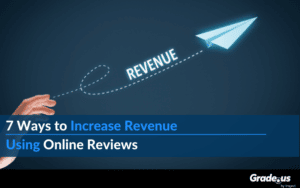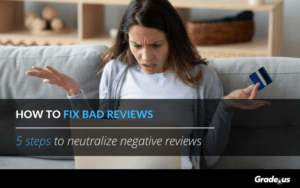This is crazy.
Is there value in “bad reviews?” This is a very good question. Negative reviews have a negative impact on your business.
So why would anyone want bad reviews?
As you’ll soon see, negative reviews are an indispensable part of the reputation management process. Sophisticated sellers pursue both positive and negative reviews. Inexperienced sellers focus exclusively on positive reviews.
Let’s take a closer look at these bad reviews.
The unexpected value of bad reviews
Value? What value?
If we look at the research, we see that there are a lot of unpleasant consequences that come with negative reviews.
Here’s an example.
According to Inc. magazine, “it takes roughly 40 positive customer experiences to undo the damage of a single negative review.”
Well that’s horrible.
There’s not much upside until we see this. 82% of customers seek out negative reviews.
Still no upside there…
Actually it is. You know most of your customers are going to look for dirt on you.
This is great news.
Your customer’s default is distrust. As a general rule, your customers have two mindsets. Optimism or pessimism. Optimists are easy to sell to, but harder to keep. Pessimists, on the other hand, are harder to sell to, but easier to keep.
The data backs this up.
A meta-analysis by Bart S. Vanneste et al. proves the point. Here’s what these researchers found.
- Trustors (customers) enter into a relationship with trustees (you).
- Trustors use your “perceived trustworthiness” as the fuel or spark they need to take a risk.
- Trustors then adjust their perception to match reality.
Here’s where it gets tricky.
- Optimist trustors overestimate trustworthiness. They assign more trustworthiness to you initially. The bad news? Their trust in you decreases over time, they overestimated after all. Even worse, their trust will continue to decline if the gains they receive continue to decline.
- Pessimist trustors underestimate trustworthiness. They assign little to no trustworthiness initially. Any trust that’s given has to be earned. As a result, their trust is likely to increase over time. Their trust will continue to increase so long as the gains continue.
Here’s what this means.
Answer a pessimist’s initial objections, defuse the skepticism they bring with them and you’re in. Pessimists require more work on the front end.
Optimists require more work on the back end but they’re far more likely to be pleased with the upfront work you’ve done than pessimists. Work to please your pessimists and you serve both.
Why you need bad reviews
- Research from Womply shows that businesses whose total number of reviews are 15-20% negative average 13% more annual revenue than businesses whose reviews are 5-10% negative.
- Revoo found that time on site is 5x longer when customers interact with negative reviews, producing an 85% increase in conversion.
- Negative reviews establish credibility. Readers are skeptical of reviews that are too positive and, in many cases, a negative online review is seen as more credible.
How are you supposed to get the benefits of negative reviews while also avoiding the significant downsides?
Is that possible?
Absolutely. Focus your attention on building the right ratio of positive and negative reviews!
What’s the right ratio?
Research conducted by Emily Heaphy and Marcial Losada, found the ideal praise-to-criticism ratio is 5 to 1. Five positive interactions for every negative interaction.
Heaphy and Losada studied the impact this ratio has on teams inside a company. Here’s where it gets interesting. They found this applied to customer interactions as well.
That’s right.
At least five positive reviews for every negative review. Here’s why that’s important. Trust, specifically trustworthiness, is an expression of consistency and reliability over time.
So what am I suggesting, that you specifically request negative reviews?
How to get negative reviews
This is insane, no one wants bad reviews, right? Actually no, if you’re a sophisticated seller, you want some negative reviews.
So how do you get them?
The same way you get positive reviews, you ask for them. Why on earth would you do that? Because it makes your relationship stronger.
Think about it for a second.
What do most review requests look like?
Hi Customer,
I wanted to reach out and ask if you’d be willing to write a review of your recent visit to our store. If you’re willing, it would really help our business.
Thanks so much,
[Signature]
What’s wrong with that?
Nothing, if your experience is a good one. If your customer’s experience is a negative one, this is suddenly a problem. If they’re afraid of conflict, these customers are likely to ghost your business. They’ll avoid you so they can avoid any unnecessary drama.
What if they’re interested in conflict?
Your request has made things worse. Their experience with you was unpleasant (strike one). You’re so out of touch that you’re asking them for a positive review (strike two). You don’t know how bad things are (strike three).
Well, now they’re eager to write a negative review for your business.
If you were apologetic they might have taken it easy on you. But now, they’re out to put you in your place. They’re going to write a scathing review that lists all of the unpleasant details of their experience.
Yikes.
Okay, how do we fix this?
It’s easy. Avoid making any positive assumptions in your review requests. Here’s what that looks like.
Hi Customer,
[Name] here. I’m the [Title] at [Company]. I had a question for you.
Did we make you happy?
I need to know if we’ve let you down in any way. How do you feel we performed?
Please let us know [here].
Best,
[Signature]
See the difference? Here’s another one.
Hi Customer,
[Name] here. I’m the [Title] at [Company]. I’m reaching out to ask — did we take good care of you?
Would you be willing to share your feedback? I want to hear it all, the good, the bad, and the ugly (I can take it).
Share your feedback [directly with me].
Appreciate you!
[Signature]
See the difference?
Your customers receive the implicit message that it’s okay for them to deliver the bad news. You’re more interested in taking care of them than you are with scoring a five-star review. As you’d probably expect, this is the kind of attitude that produces five-star reviews!
But bad reviews are scary!
What if a negative review hurts my business severely? Let’s go over a simple strategy you can use to decrease the damage directly.
How to minimize or eliminate the damage of a negative review
Customers have already given us the answer.
- 89% of travelers said a thoughtful response to a negative review improved their impression of a business.
- When a patient’s negative feedback is addressed by the practice, the rate of patient satisfaction roughly doubles, increasing 99%.
- 89% of consumers read local businesses’ responses to reviews
What does this tell us?
Responding to negative reviews improves your brand and increases conversion rates. Customers see that you’re trying to improve and they’re willing to give you a second chance.
How do you respond?
- Thank customers for reaching out
- Take ownership of the customer’s experience
- Apologize for what you can
- Explain what happened and why
- Tell them how you’re going to fix the problem
It’s that simple.
This is how you minimize or eliminate the fallout from a negative review.
Your business needs negative reviews
As we’ve seen, negative reviews are an indispensable part of the reputation management process. Sophisticated sellers pursue both positive and negative reviews while inexperienced sellers focus exclusively on positive reviews.
Give your customers a choice.
Negative reviews, when they’re handled well, boost credibility, increase conversions, and strengthen customer relationships.
Focus your attention on building a positive customer experience and the right ratio of positive and negative reviews will happen organically. Do this right and you’ll find your conversions and revenue increase dramatically.










